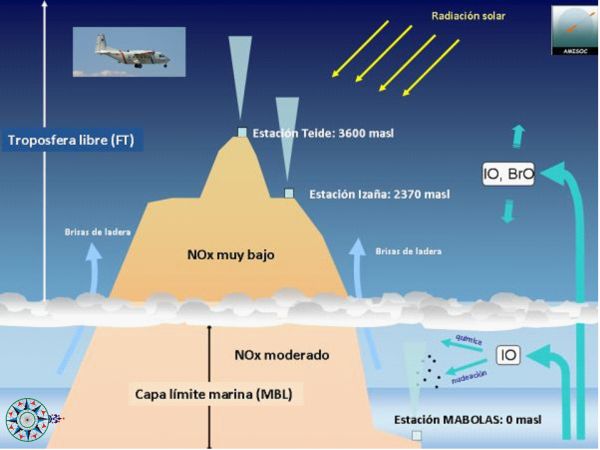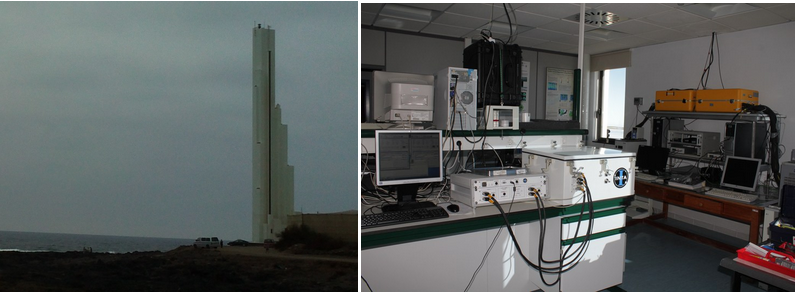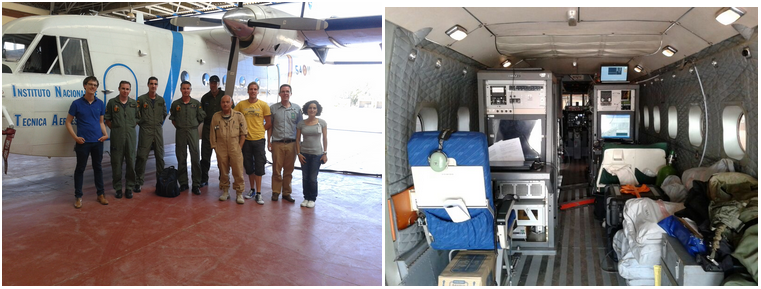Project AMISOC: Campaign in Tenerife for detecting and monitoring the vertical distribution of minor constituents. Impact of Saharan mineral dust on their concentrations.
![]()
The Project AMISOC, from the National Research Programme headed by INTA (National Institute of Aerospacial Technique), aims to improve the knowledge of the minor constituents in the atmosphere playing a role in the ozone chemistry. In particular, the project analyses the vertical distribution of bromine monoxide (BrO) and iodine monoxide (IO), understudied gases that contribute efficiently to remain ozone concentrations as observed levels. Also, their effects during Saharan dust outbreaks will be studied.
It is believed that these species are produced by the sea and transported by wind to the upper layers of the atmosphere. However, the concentrations measured are higher than expected. For this reason, a measurement campaign has been carried out in July 2013 in Tenerife Island, where the geography allows us to take measurements at different altitudes between sea level and about 3600 m a.s.l. For the campaign three stations were established in Tenerife: one at sea level, one in the Izaña Atmospheric Observatory and the third one at the peak of Teide. By using identical instrumentation at the three stations the vertical distribution of BrO, IO, ozone (O3) and nitrogen dioxide (NO2) were measured. These observations are complemented by vertical profiles of desert mineral dust particles during Saharan outbreaks, made by the scientific aircraft C-212 from INTA.

Figure 1. Scheme of the AMISOC campaign (Source: www.amisoc.es).
The instrumentation used during the campaign and their location has been, with three locations:
1) MABOLAS (Marine Boundary Layer Station), located at sea level and with three locations:
a) Santa Cruz de Tenerife Station from Izaña Atmospheric Research Centre (IARC), with a LIDAR MPL.
b) Lighthouse of Punta del Hidalgo (facilities from Autoridad Portuaria de Santa Cruz de Tenerife, www.puertosdetenerife.org/inicio.asp, Figure 2), with an analyser for measuring nanoparticles from natural source.
c) Bajamar Station, where the MAXDOAS and an instrument for measuring in-situ NOx have been installed.
2) IZAÑA, located in the free troposphere and with two stations:
a) Izaña Atmospheric Observatory from the CIAI-AEMET, where the MAXDOAS from INTA routinely operate since 1999 (Figure 2). Furthermore, an analyser for inorganic mercury from the University of Manitoba has been installed.
b) Facilities from the Instituto Astrofísica de Canarias, with a LP-DOAS from the Atmospheric Chemistry and Climate (AC2) group-CSIC.

Figure 2. Lighthouse of Punta del Hidalgo (left) and instrumentation from INTA installed at IAO (right) (Source: www.amisoc.es).
3) TEIDE. Facilities of the Teide Cable Car at 3550 m a.s.l., (http://www.telefericoteide.com/), where two MAXDOAS were installed: one from AIIA-INTA and another one from AC2-CSIC.
4) SCIENTIFIC AIRCRAFT C-212, with the following instrumentation (Figure 3):
a) PCASP-100 X Sonde, that measures the aerosol size distribution from 0.1 to 3.0 micrometers (15 channels)
b) CAPS Sonde (Multipurpose Sonde), that observes the aerosol size distribution, water droplet size distribution, the liquid water content, takes 2D images of water droplets, vertical profiles of pressure, temperature and relative humidity as well as GPS location.
c) Sondes for temperature, dew point, atmospheric pressure and GPS location.

Figure 3. Scientific aircraft C-212 from INTA and part of the crew and scientific-technical staff involved in the MUSICA campaign (from left to right: Garlich Fischbeck (KIT), Ángel (CLAEX), Saba (CLAEX), Fran (CLAEX), Oscar Serrano (INTA), Luis Otero (INTA), Christoph Dyroff (KIT), Ángel Gómez-Peláez (AEMET) and Neves Seoane (INTA)). The right image shows all instrumentation installed inside the aircraft C-212.







